Simulated Assessment of Summer Maize Drought Loss Sensitivity in Huaibei Plain, China
Abstract
1. Introduction
2. Materials and Methods
2.1. Summer Maize Pit Plot Experiments
2.2. Experimental Measurements
2.2.1. Soil Water Content
2.2.2. Summer Maize Phenophase
2.2.3. Maize Dry Matter Accumulation and Grain Yield
2.3. CSM-CERES-Maize Model Data Input
2.3.1. Soil Data
2.3.2. Meteorological Data
2.4. Drought Patterns Setting
2.5. Maize Drought Loss Sensitivity Curve
2.5.1. Drought Hazard Index
2.5.2. Drought Loss Rates of Maize Dry Matter Accumulation and Grain Yield
3. Results and Discussion
3.1. Calibration and Validation of Summer Maize Genetic Parameters
3.2. Soil Water Deficit (SWD)
3.3. Maize Evapotranspiration
3.4. Summer Maize Sensitivity Curves
4. Conclusions
Author Contributions
Funding
Acknowledgments
Conflicts of Interest
References
- IPCC (Intergovernmental Panel on Climate Change). IPCC Expert Meeting Report: Towards New Scenarios for Analysis of Emissions, Climate Change, Impacts, and Response Strategies; Intergovernmental Panel on Climate Change: Noordwijikerhout, The Netherlands, 2007.
- Mishra, A.K.; Singh, V.P. Drought modeling-A review. J. Hydrol. 2011, 403, 157–175. [Google Scholar] [CrossRef]
- Hao, L.; Zhang, X.Y.; Liu, S.D. Risk assessment to China’s agricultural drought disaster in county unit. Nat. Hazards 2012, 61, 785–801. [Google Scholar] [CrossRef]
- Leng, G.Y.; Tang, Q.H.; Rayburg, S. Climate change impacts on meteorological, agricultural and hydrological droughts in China. Glob. Planet. Chang. 2015, 126, 23–34. [Google Scholar] [CrossRef]
- IPCC (Intergovernmental Panel on Climate Change). Managing the Risks of Extreme Events and Disasters to Advance Climate Change Adaptation: Special Report of the Intergovernmental Panel on Climate Change; Cambridge University Press: New York, NY, USA, 2012.
- Wilhite, D.A.; Svoboda, M.D.; Hayes, M.J. Understanding the complex impacts of drought: A key to enhancing drought mitigation and preparedness. Water Resour. Manag. 2007, 21, 763–774. [Google Scholar] [CrossRef]
- Jin, J.L.; Song, Z.Z.; Cui, Y.; Jiang, S.M.; Zhou, Y.L. Research progress on the key technologies of drought risk assessment and control. J. Hydraul. Eng. 2016, 47, 398–412. [Google Scholar] [CrossRef]
- Shi, P.J. Theory on disaster science and disaster dynamics. J. Nat. Disasters 2002, 11, 1–9. [Google Scholar]
- Wilhelmi, O.V.; Wilhite, D.A. Assessing vulnerability to agricultural drought: A Nebraska case study. Nat. Hazards 2002, 25, 37–58. [Google Scholar] [CrossRef]
- Ganji, A.; Ponnambalam, K.; Khalili, D.; Karamouz, M. Grain yield reliability analysis with crop water demand uncertainty. Stoch. Environ. Res. Risk Assess. 2006, 20, 259–277. [Google Scholar] [CrossRef]
- Hao, Z.C.; Aghakouchak, A. Multivariate standardized drought index: A parametric multi-index model. Adv. Water Resour. 2013, 57, 12–18. [Google Scholar] [CrossRef]
- Cui, Y.; Jiang, S.M.; Jin, J.L.; Yuan, H.W.; Zhou, Y.L. Soybean drought loss sensitivity assessment based on water deficit experiment. J. Hydroelectr. Eng. 2017, 36, 50–61. [Google Scholar] [CrossRef]
- Boonjung, H.; Fukai, S. Effects of soil water deficit at different growth stages on rice growth and yield under upland conditions. 1. Growth during drought. Field Crops Res. 1996, 48, 37–45. [Google Scholar] [CrossRef]
- Wilhelmi, O.V. Methodology for Assessing Vulnerability to Agricultural Drought: A Nebraska Case Study. Ph.D. Thesis, University of Nebraska, Lincoln, NE, USA, 1999. [Google Scholar]
- Jones, J.W.; Hoogenboom, G.; Porter, C.H.; Boote, K.J.; Batchelor, W.D.; Hunt, L.A.; Wilkens, P.W.; Singh, U.; Gijsman, A.J.; Ritchie, J.T. The DSSAT cropping system model. Eur. J. Agronomy 2003, 18, 235–265. [Google Scholar] [CrossRef]
- Dirk, R.; Pasquale, S.; Theodore, C.H.; Elias, F. AquaCrop—The FAO crop model to simulate yield response to water: II. Main algorithms and software description. Agronomy J. 2009, 101, 448–459. [Google Scholar] [CrossRef]
- Asseng, S.; Keating, B.A.; Fillery, I.R.P.; Gregory, P.J.; Bowden, J.W.; Turner, N.C.; Palta, J.A.; Abrecht, D.G. Performance of the APSIM-wheat model in Western Australia. Field Crops Res. 1998, 57, 163–179. [Google Scholar] [CrossRef]
- Riboli, E. The EPIC project: Rationale and study design. Int. J. Epidemiol. 1997, 26, 6–14. [Google Scholar] [CrossRef]
- Araya, A.; Keesstra, S.D.; Stroosnijder, L. Corrigendum to “Simulating yield response to water of Teff (Eragrostis tef) with FAO’s AquaCrop model” [Field Crops Res. 116 (2010) 196–204]. Field Crops Res. 2010, 117, 265. [Google Scholar] [CrossRef]
- Attia, A.; Rajan, N.; Xue, Q.W.; Nair, S.; Ibrahim, A.; Hays, D. Application of DSSAT-CERES-Wheat model to simulate winter wheat response to irrigation management in the Texas High Plains. Agric. Water Manag. 2016, 165, 50–60. [Google Scholar] [CrossRef]
- Yue, Y.J.; Li, J.; Ye, X.Y.; Wang, Z.Q.; Zhu, A.X.; Wang, J.A. An EPIC model-based vulnerability assessment of wheat subject to drought. Nat. Hazards 2015, 78, 1629–1652. [Google Scholar] [CrossRef]
- Yin, Y.Y.; Zhang, X.M.; Lin, D.G.; Yu, H.; Wang, J.A.; Shi, P.J. GEPIC-V-R model: A GIS-based tool for regional crop drought risk assessment. Agric. Water Manag. 2014, 144, 107–119. [Google Scholar] [CrossRef]
- Wu, H.; Qian, H.; Chen, J.; Huo, C.C. Assessment of agricultural drought vulnerability in the Guanzhong Plain, China. Water Resour. Manag. 2017, 31, 1557–1574. [Google Scholar] [CrossRef]
- Kamali, B.; Abbaspour, K.C.; Lehmann, A.; Wehrli, B.; Yang, H. Spatial assessment of maize physical drought vulnerability in sub-Saharan Africa: Linking drought exposure with crop failure. Environ. Res. Lett. 2018, 13, 074010. [Google Scholar] [CrossRef]
- Chen, G.Q.; Liu, H.J.; Zhang, J.W.; Liu, P.; Dong, S.T. Factors affecting summer maize yield under climate change in Shandong Province in the Huanghuaihai Region of China. Int. J. Biometeorol. 2012, 56, 621–629. [Google Scholar] [CrossRef] [PubMed]
- Geng, S.M.; Yan, D.H.; Yang, Z.Y.; Zhang, B.Z.; Yang, M.J.; Kan, G.Y. Characteristics analysis of summer maize yield loss caused by drought stress in the Northern Huaihe Plain, China. Irrigation Drain. 2017, 67, 251–268. [Google Scholar] [CrossRef]
- Shen, S.Y.; Xi, C.F. Model and analysis of the natural productive potential of agriculture of the Guo River watershed in Northern Anhui, China. J. Nat. Resour. 1991, 1, 22–33. [Google Scholar] [CrossRef]
- Turner, N.C. Crop water deficits: A decade of progress. Adv. Agronomy 1986, 39, 1–51. [Google Scholar] [CrossRef]
- Zadoks, J.C.; Chang, T.T.; Konzak, C.F. A decimal code for the growth stages of cereals. Weed Res. 1974, 14, 415–421. [Google Scholar] [CrossRef]
- Angstrom, A.S. Solar and terrestrial radiation. Report to the international commission for solar research on actinometric investigations of solar and atmospheric radiation. Q. J. R. Meteorol. Soc. 2010, 50, 121–126. [Google Scholar] [CrossRef]
- Yu, J.J.; Qin, X.S.; Larsen, O. Joint Monte Carlo and possibilistic simulation for flood damage assessment. Stoch. Environ. Res. Risk Assess. 2013, 27, 725–735. [Google Scholar] [CrossRef]
- Jia, H.C.; Wang, J.A.; Cao, C.X.; Pan, D.H.; Shi, P.J. Maize drought disaster risk assessment of China based on EPIC model. Int. J. Digit. Earth 2012, 5, 488–515. [Google Scholar] [CrossRef]
- Wang, Z.Q.; He, F.; Fang, W.H.; Liao, Y.F. Assessment of physical vulnerability to agricultural drought in China. Nat. Hazards 2013, 67, 645–657. [Google Scholar] [CrossRef]
- Cui, Y.; Jiang, S.M.; Jin, J.J.; Ning, S.W.; Feng, P. Quantitative assessment of soybean drought loss sensitivity at different growth stages based on S-shaped damage curve. Agric. Water Manag. 2019, 213, 821–832. [Google Scholar] [CrossRef]
- Chen, M.J.; Ma, J.; Hu, Y.J.; Zhou, F.; Li, J.X.; Yan, L. Is the S-shaped curve a general law? An application to evaluate the damage resulting from water-induced disasters. Nat. Hazards 2015, 78, 497–515. [Google Scholar] [CrossRef]
- Nam, W.H.; Hayes, M.J.; Svoboda, M.D.; Tadesse, T.; Wilhite, D.A. Drought hazard assessment in the context of climate change for South Korea. Agric. Water Manag. 2015, 160, 106–117. [Google Scholar] [CrossRef]
- Chen, J.L.; Kang, S.Z.; Du, T.S.; Qiu, R.J.; Guo, P.; Chen, R.Q. Quantitative response of greenhouse tomato yield and quality to water deficit at different growth stages. Agric. Water Manag. 2013, 129, 152–162. [Google Scholar] [CrossRef]
- Sincik, M.; Candogan, B.N.; Demirtas, C.; Büyükcangaz, H.; Yazgan, S.; Göksoy, A.T. Deficit irrigation of soya bean [Glycine max (L.) Merr.] in a sub-humid climate. J. Agronomy Crop Sci. 2008, 194, 200–205. [Google Scholar] [CrossRef]
- Yakoub, A.; Lloveras, J.; Biau, A.; Lindquist, J.L.; Lizaso, J.I. Testing and improving the maize models in DSSAT: Development, growth, yield, and N uptake. Field Crops Res. 2017, 212, 95–106. [Google Scholar] [CrossRef]
- Costa, C.; Dwyer, L.M.; Zhou, X.M.; Dutilleul, P.; Hamel, C.; Reid, L.M.; Smith, D.L. Root morphology of contrasting maize genotypes. Agronomy J. 2002, 94, 96–101. [Google Scholar] [CrossRef]
- Cakir, R. Effect of water stress at different development stages on vegetative and reproductive growth of corn. Field Crops Res. 2004, 89, 1–16. [Google Scholar] [CrossRef]
- Acevedo, E.; Hsiao, T.C.; Henderson, D.W. Immediate and subsequent growth responses of maize leaves to changes in water status. Plant Physiol. 1971, 48, 631–636. [Google Scholar] [CrossRef]
- Xu, Z.Z.; Zhou, G.S.; Shimizu, H. Plant responses to drought and rewatering. Plant Signal. Behav. 2010, 5, 649–654. [Google Scholar] [CrossRef]
- Pandey, R.K.; Maranville, J.W.; Admou, A. Deficit irrigation and nitrogen effects on maize in a Sahelian environment: I. Grain yield and yield components. Agric. Water Manag. 2000, 46, 1–13. [Google Scholar] [CrossRef]
- Igbadun, H.E.; Salim, B.A.; Tarimo, A.K.P.R.; Mahoo, H.F. Effects of deficit irrigation scheduling on yields and soil water balance of irrigated maize. Irrigation Sci. 2008, 27, 11–23. [Google Scholar] [CrossRef]
- Stone, P.J.; Wilson, D.R.; Reid, J.B.; Gillespie, R.N. Water deficit effects on sweet corn. I. Water use, radiation use efficiency, growth, and yield. Aust. J. Agric. Res. 2001, 52, 103–113. [Google Scholar] [CrossRef]
- Ribaut, J.M.; Hoisington, D.A.; Deutsch, J.A.; Jiang, C.; Gonzalez-de-Leon, D. Identification of quantitative trait loci under drought conditions in tropical maize. 1. Flowering parameters and the anthesis-silking interval. Theoret. Appl. Genet. 1996, 92, 905–914. [Google Scholar] [CrossRef] [PubMed]
- Skirycz, A.; Inzé, D. More from less: Plant growth under limited water. Curr. Opin. Biotechnol. 2010, 21, 197–203. [Google Scholar] [CrossRef] [PubMed]
- Farré, I.; Faci, J.M. Deficit irrigation in maize for reducing agricultural water use in a Mediterranean environment. Agric. Water Manag. 2009, 96, 383–394. [Google Scholar] [CrossRef]

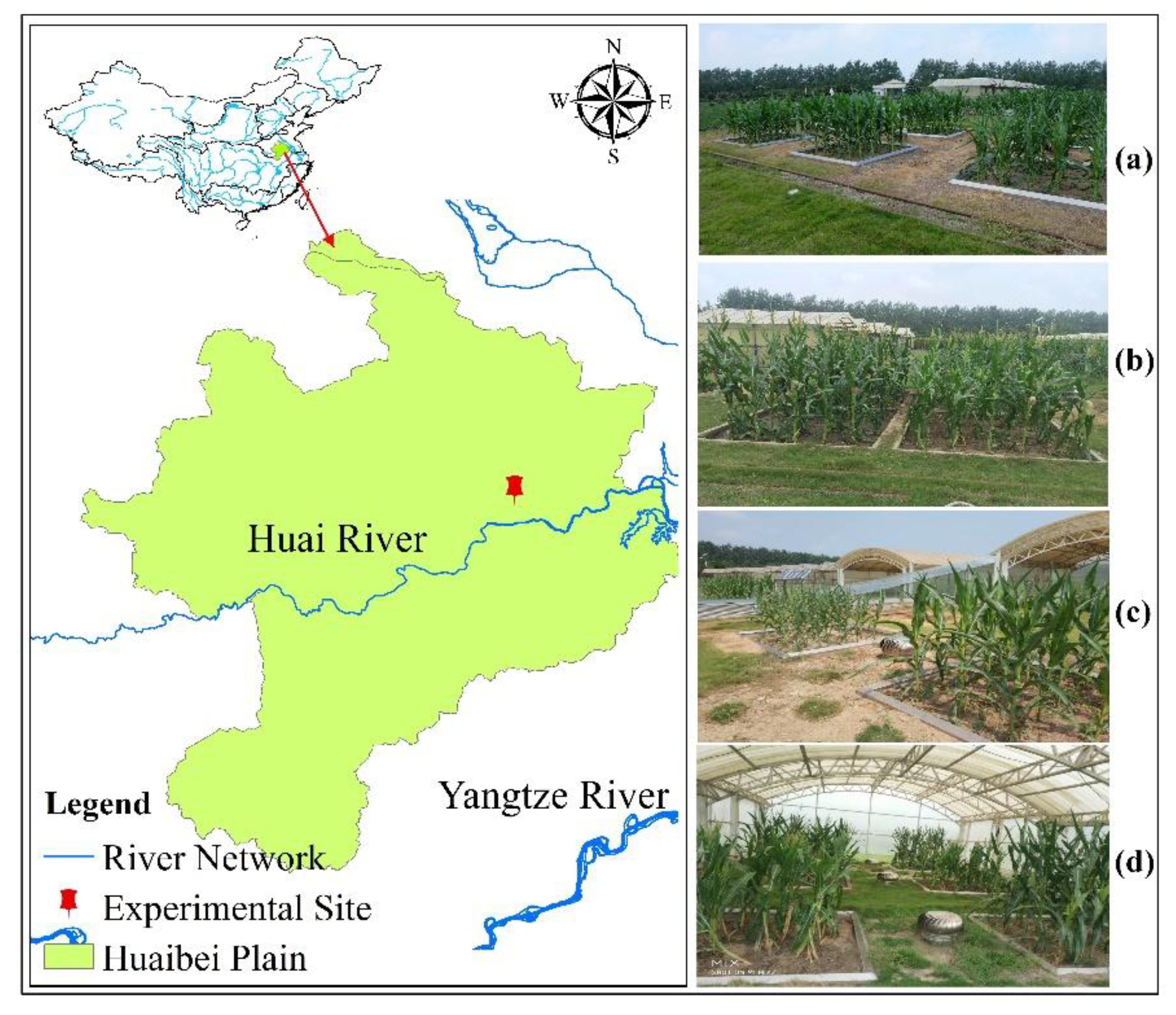
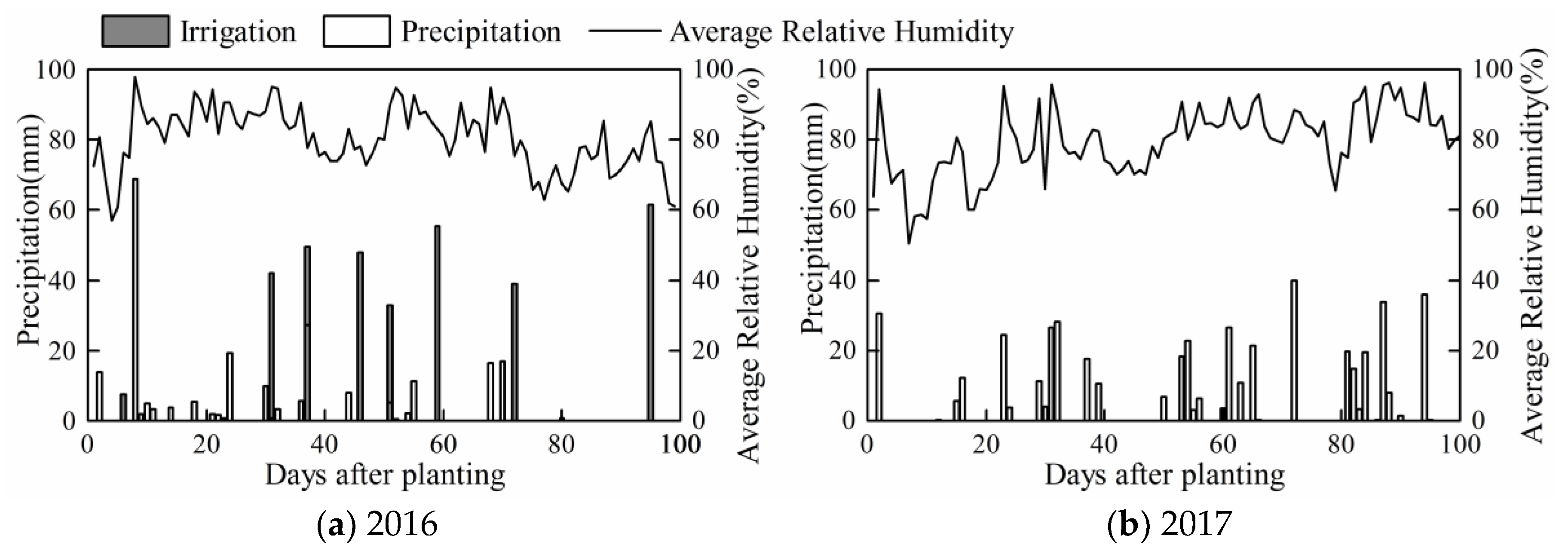
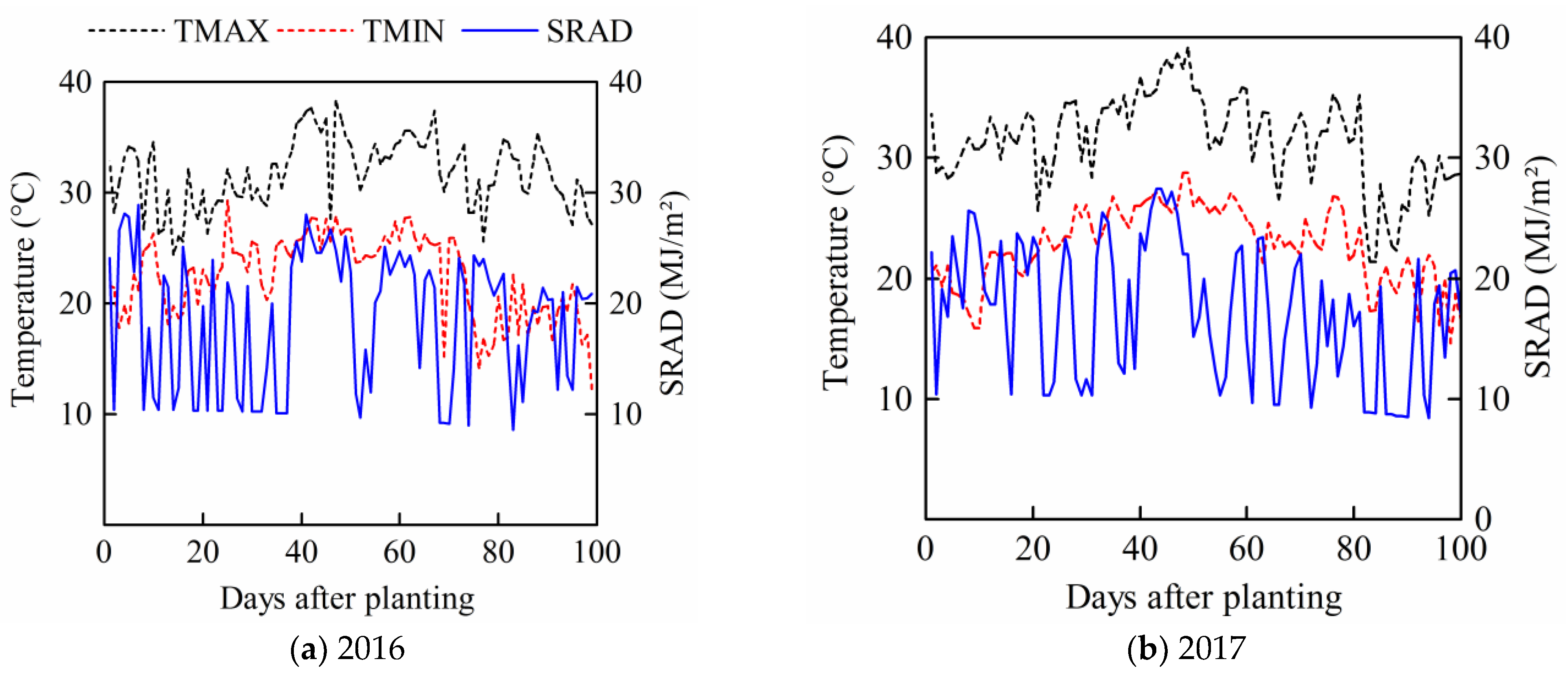
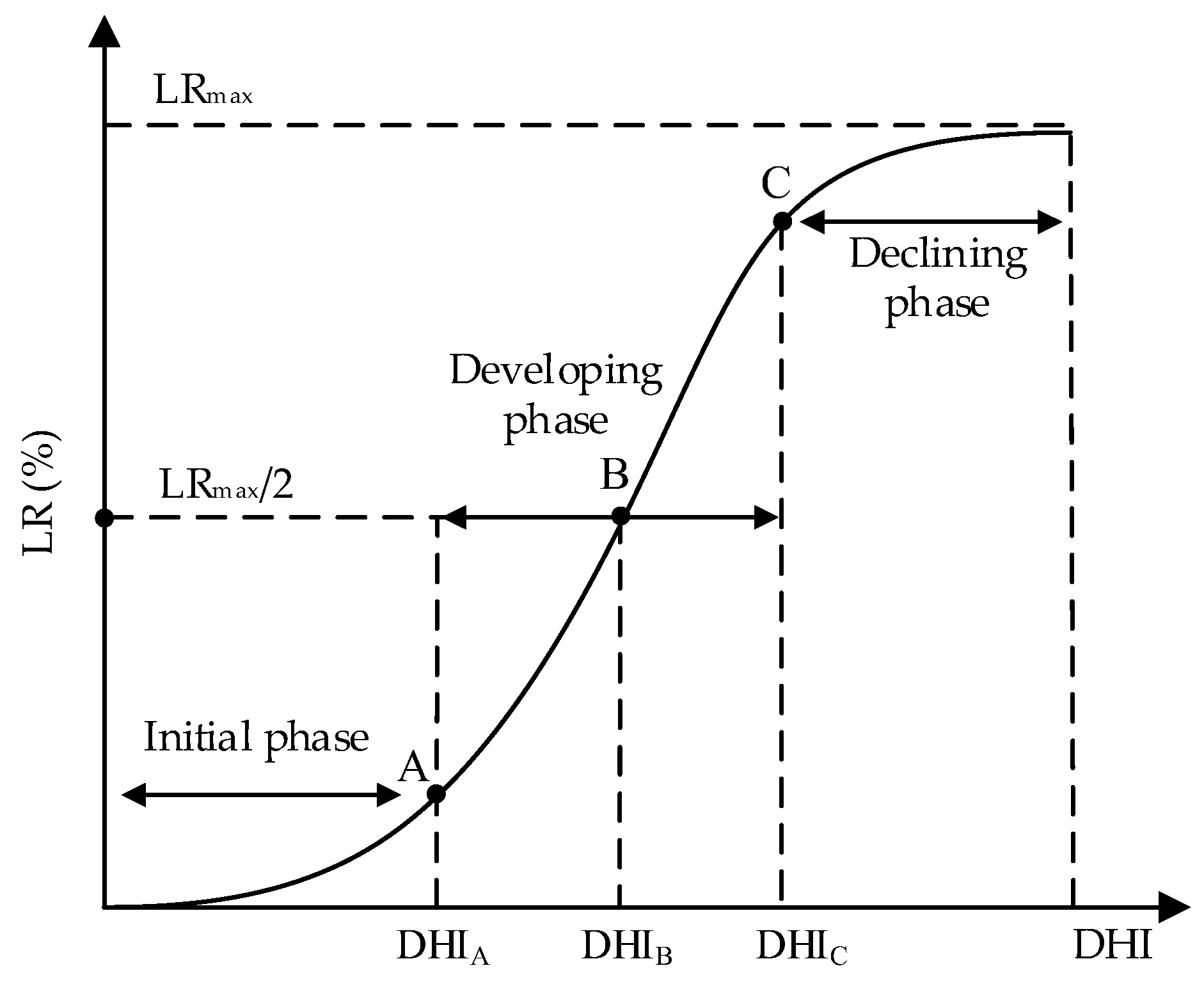
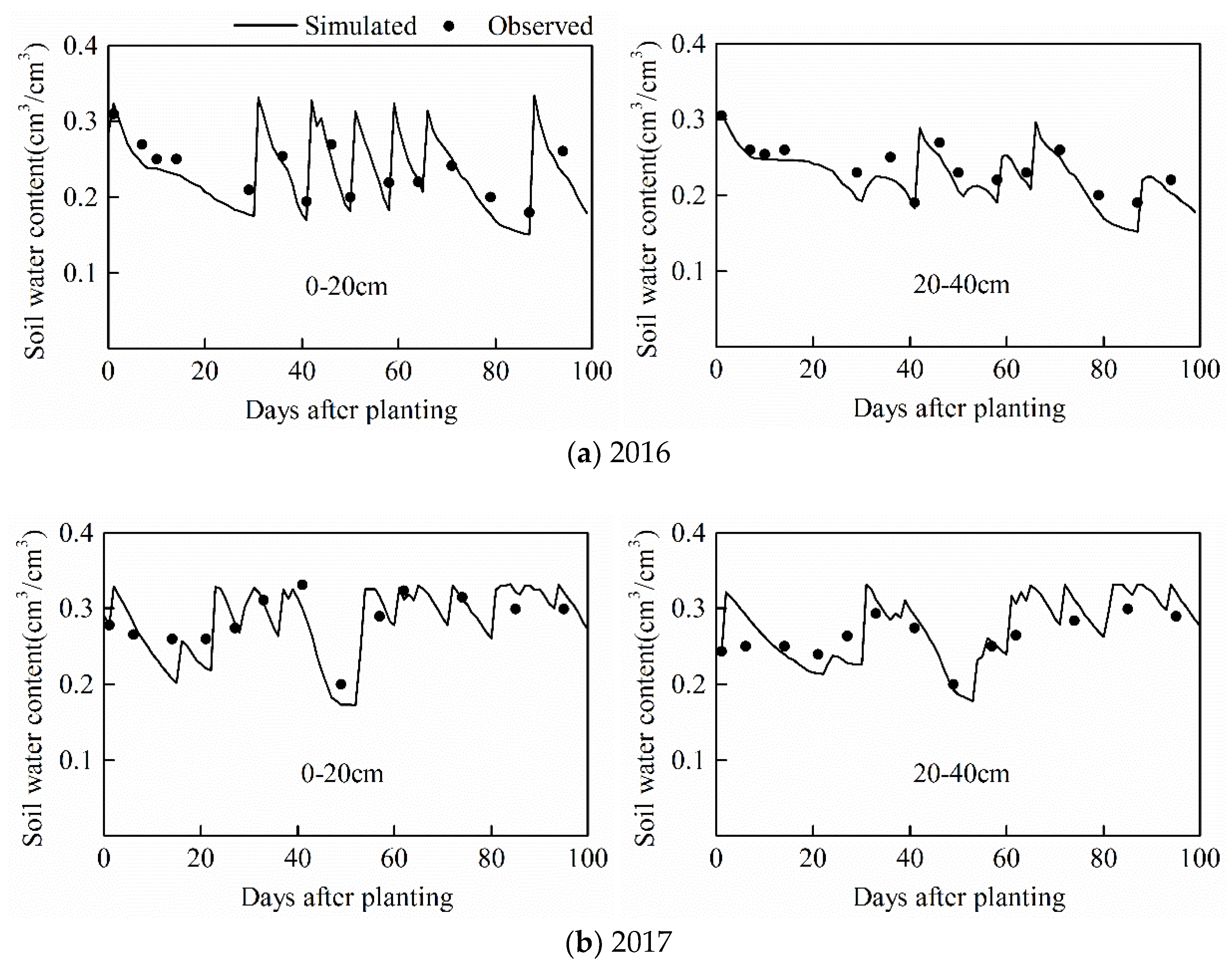
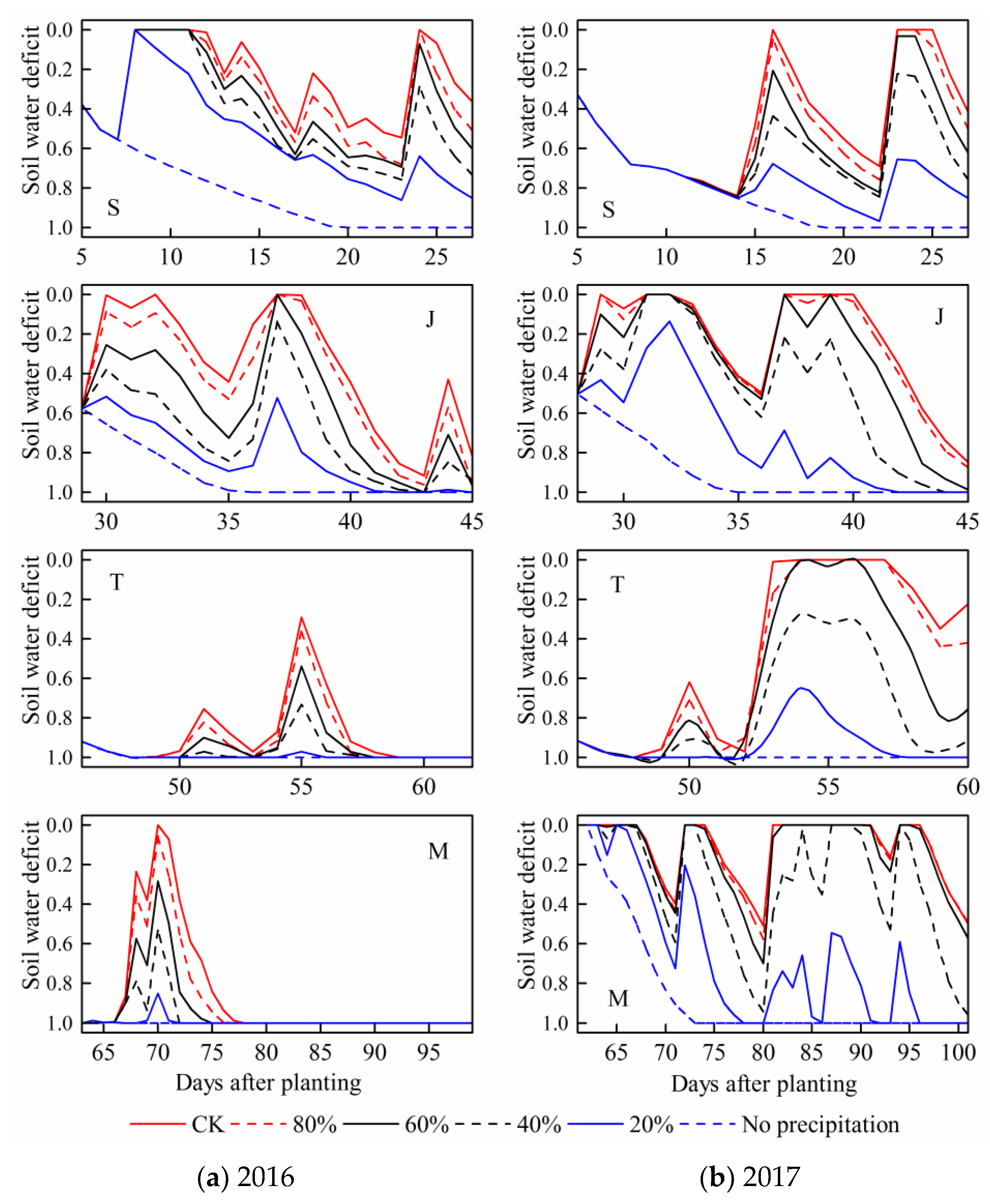
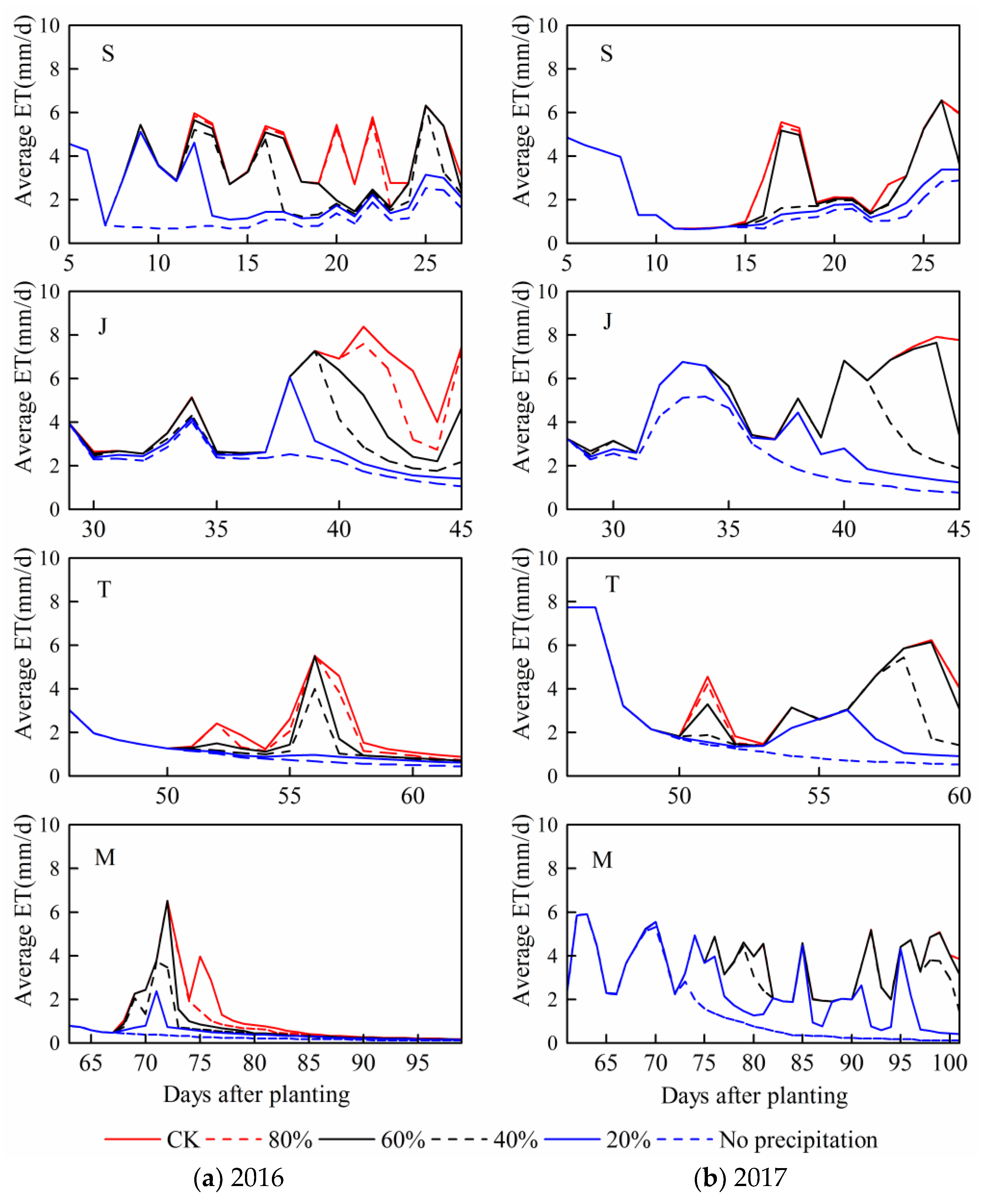

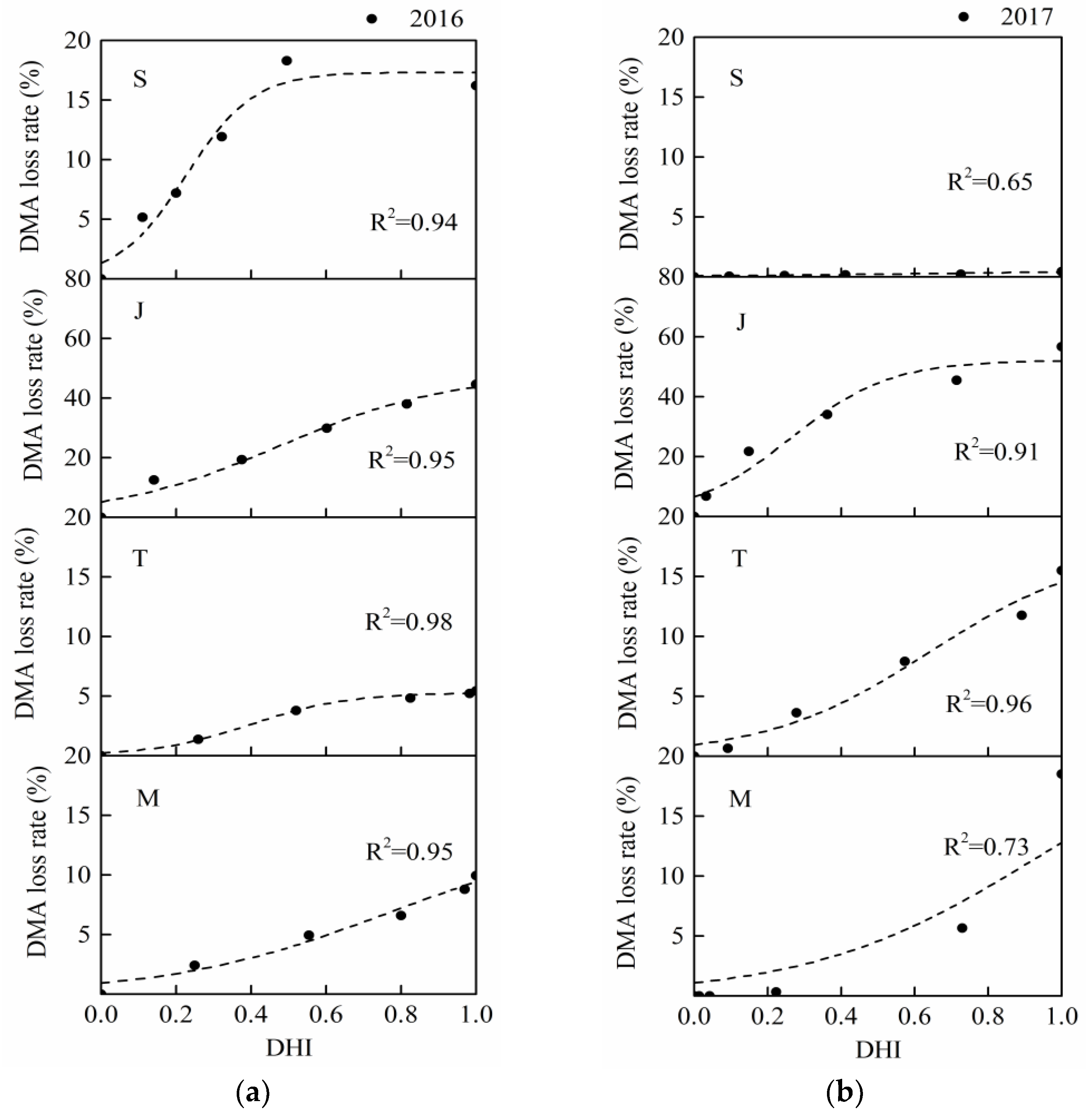
| Stage | Description | 2016 | 2017 |
|---|---|---|---|
| S | Seedling stage, from seed germination to plants with first detectable node | From June 18 to July 11, 24 days | From June 14 to July 6, 23 days |
| J | Jointing stage, from plants with first detectable node to first visible ear tip appearance | From July 12 to July 29, 18 days | From July 7 to July 23, 17 days |
| T | Tasseling stage, from first visible ear tip appearance to the beginning of grain-filling | From July 30 to August 15, 17 days | From July 24 to August 8, 16 days |
| M | Milking stage, from the beginning of grain-filling to plants maturation | From August 16 to September 25, 31 days | From August 9 to September 21, 34 days |
| Soil Layer | Bulk Density (g/cm3) | Clay (%) | Silt (%) | Initial Soil Water Content (cm3/cm3) | |
|---|---|---|---|---|---|
| 2016 Season | 2017 Season | ||||
| 0–10 cm | 1.33 | 25 | 70 | 0.25 | 0.26 |
| 10–20 cm | 1.56 | 30 | 67 | 0.28 | 0.30 |
| 20–30 cm | 1.61 | 23 | 73 | 0.26 | 0.24 |
| 30–40 cm | 1.55 | 25 | 71 | 0.28 | 0.25 |
| Drought Pattern | Percentage of Actual Precipitation Amount | Description | |||
|---|---|---|---|---|---|
| Seedling Stage | Jointing Stage | Tasseling Stage | Milking Stage | ||
| CK | 100% | 100% | 100% | 100% | Natural rain-fed condition during the whole summer maize growth period |
| T1-1 | 80% | 100% | 100% | 100% | Five degrees of drought stress during the seedling stage |
| T1-2 | 60% | 100% | 100% | 100% | |
| T1-3 | 40% | 100% | 100% | 100% | |
| T1-4 | 20% | 100% | 100% | 100% | |
| T1-5 | 0 | 100% | 100% | 100% | |
| T2-1 | 100% | 80% | 100% | 100% | Five degrees of drought stress during the jointing stage |
| T2-2 | 100% | 60% | 100% | 100% | |
| T2-3 | 100% | 40% | 100% | 100% | |
| T2-4 | 100% | 20% | 100% | 100% | |
| T2-5 | 100% | 0 | 100% | 100% | |
| T3-1 | 100% | 100% | 80% | 100% | Five degrees of drought stress during the tasseling stage |
| T3-2 | 100% | 100% | 60% | 100% | |
| T3-3 | 100% | 100% | 40% | 100% | |
| T3-4 | 100% | 100% | 20% | 100% | |
| T3-5 | 100% | 100% | 0 | 100% | |
| T4-1 | 100% | 100% | 100% | 80% | Five degrees of drought stress during the milking stage |
| T4-2 | 100% | 100% | 100% | 60% | |
| T4-3 | 100% | 100% | 100% | 40% | |
| T4-4 | 100% | 100% | 100% | 20% | |
| T4-5 | 100% | 100% | 100% | 0 | |
| Genetic Parameter | Description | Range of Values | Calibrated Values |
|---|---|---|---|
| P1 (°C day) | Thermal time from seed emergence to the end of juvenile phase during which the plant is not responsive to photoperiod | 100–400 | 106.7 |
| P2 (day) | Delay in development (days) for each hour that day length is above 12.5 h. If the day length is less than 12.5 h, development occurs at maximum rate | 0–4 | 2.1 |
| P5 (°C day) | Thermal time from silking to physiological maturity | 600–1000 | 995.5 |
| G2 (kernel) | Maximum possible number of kernels per plant | 500–1000 | 502.3 |
| G3 (mg kernel−1 day −1) | Kernel growth rate during the linear grain-filling stage under optimum conditions | 5–12 | 10.3 |
| PHINT (°C day) | The interval in thermal time between successive leaf tip appearances | 30–75 | 38.9 |
| Cropping Season | Date of Beginning of Flowering (Day after Planting) | Date of Beginning of Maturity (Day after Planting) | Grain Yield (kg/hm2) | Dry Matter Accumulation at Harvest Time (kg/hm2) | ||||||||||||
|---|---|---|---|---|---|---|---|---|---|---|---|---|---|---|---|---|
| Sim | Obs | ARE | RRMSE | Sim | Obs | ARE | RRMSE | Sim | Obs | ARE | RRMSE | Sim | Obs | ARE | RRMSE | |
| 2016 (calibration) | 45 | 45 | 0.00% | 0.00% | 98 | 95 | 3.16% | 3.55% | 4987 | 5117 | 2.54% | 2.17% | 12,722 | 13,753 | 7.50% | 6.29% |
| 2017 (validation) | 46 | 46 | 0.00% | 100 | 104 | 3.85% | 6717 | 6847 | 1.90% | 14,035 | 14,776 | 5.01% | ||||
| Soil Layer | 2016 Season | 2017 Season | ||||
|---|---|---|---|---|---|---|
| Sim (cm3/cm3) | Obs (cm3/cm3) | RRMSE | Sim (cm3/cm3) | Obs (cm3/cm3) | RRMSE | |
| 0–20 cm | 0.233 | 0.235 | 9.47% | 0.284 | 0.285 | 8.68% |
| 20–40 cm | 0.225 | 0.238 | 8.84% | 0.275 | 0.262 | 9.76% |
| Maize Growth Stage | LR = LRmax/(1 + α×e−β × DHI) | |||||||
|---|---|---|---|---|---|---|---|---|
| Grain Yield Loss | ||||||||
| LRmax | α | β | R2 | |||||
| 2016 | 2017 | 2016 | 2017 | 2016 | 2017 | 2016 | 2017 | |
| Seedling stage | 16% | 2% | 16.11 | 8.03 | 18.80 | 2.53 | 0.72 | 0.82 |
| Jointing stage | 43% | 50% | 4.82 | 5.35 | 3.50 | 9.98 | 0.80 | 0.85 |
| Tasseling stage | 16% | 36% | 22.88 | 18.67 | 7.56 | 4.26 | 0.98 | 0.96 |
| Milking stage | 27% | 22% | 13.38 | 15.21 | 3.13 | 6.73 | 0.94 | 0.73 |
| Maize Growth Stage | LR = LRmax/(1 + α×e−β × DHI) | |||||||
|---|---|---|---|---|---|---|---|---|
| Dry Matter Accumulation Loss | ||||||||
| LRmax | α | β | R2 | |||||
| 2016 | 2017 | 2016 | 2017 | 2016 | 2017 | 2016 | 2017 | |
| Seedling stage | 17% | 1% | 12.18 | 14.16 | 11.05 | 2.82 | 0.94 | 0.92 |
| Jointing stage | 48% | 52% | 8.28 | 6.96 | 4.44 | 7.40 | 0.95 | 0.91 |
| Tasseling stage | 6% | 17% | 22.48 | 17.41 | 7.76 | 4.43 | 0.98 | 0.96 |
| Milking stage | 14% | 21% | 13.72 | 20.07 | 3.40 | 3.69 | 0.95 | 0.79 |
© 2019 by the authors. Licensee MDPI, Basel, Switzerland. This article is an open access article distributed under the terms and conditions of the Creative Commons Attribution (CC BY) license (http://creativecommons.org/licenses/by/4.0/).
Share and Cite
Wei, Y.; Jin, J.; Jiang, S.; Ning, S.; Cui, Y.; Zhou, Y. Simulated Assessment of Summer Maize Drought Loss Sensitivity in Huaibei Plain, China. Agronomy 2019, 9, 78. https://doi.org/10.3390/agronomy9020078
Wei Y, Jin J, Jiang S, Ning S, Cui Y, Zhou Y. Simulated Assessment of Summer Maize Drought Loss Sensitivity in Huaibei Plain, China. Agronomy. 2019; 9(2):78. https://doi.org/10.3390/agronomy9020078
Chicago/Turabian StyleWei, Yanqi, Juliang Jin, Shangming Jiang, Shaowei Ning, Yi Cui, and Yuliang Zhou. 2019. "Simulated Assessment of Summer Maize Drought Loss Sensitivity in Huaibei Plain, China" Agronomy 9, no. 2: 78. https://doi.org/10.3390/agronomy9020078
APA StyleWei, Y., Jin, J., Jiang, S., Ning, S., Cui, Y., & Zhou, Y. (2019). Simulated Assessment of Summer Maize Drought Loss Sensitivity in Huaibei Plain, China. Agronomy, 9(2), 78. https://doi.org/10.3390/agronomy9020078






